March Newsletter 2013 - What is the fastest way to cool a beer? Plus cold transport data logging case study
March Newsletter 2013 - What is the fastest way to cool a beer? Plus cold transport data logging case study
As some of you may know this month I am writing to you from the USA, where I have been touring around for a few weeks checking out the latest in scientific instrumentation. It has been a great trip with lots of new product discoveries as well as strengthening our relationships with current suppliers. While I have been touring around over here the team has been toiling away in the office making sure we provide you with the right products for your specific application. Although I know it hasn’t been all work and no play, the guys decided to experiment with the fastest method to cool a beer for this month’s newsletter and I know no beer would have been wasted during that experiment!
To tie in with the experiment we are talking about temperature monitoring during cold storage transport. A tricky problem to solve, taking into consideration accuracy, data reporting and cost restraints on what is often a one way single use data logger.
Remember; if you have any questions regarding tests you need to conduct or specific instrumentation please give us a call.
Until next month...
Tyson Grubb |
|
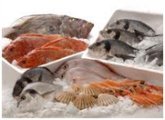
| Temperature Loggers in Cold Transport
| | Ensuring that produce is kept with a certain temperature range is essential for cold transport. If the temperature goes too high, products can spoil or lose quality (meat, fruit etc). |
If the temperature goes too low, the produce can be damaged or rendered unsuitable for use (vaccines, fruit etc). So how do you know if your produce is being shipped at the correct temperature? This is where temperature data loggers come in. Temperature data loggers are essentially a thermometer with built in memory storage. These are set up by the user to store temperature readings at an interval of their choosing (i.e. every 5 minutes). They are then placed in with the goods that are to be monitored and are left there until the shipping is complete. At the end of their journey, the data can either be downloaded by the receiver, or the unit can be popped in the post back to the supplier for them to download. Once downloaded, the data can be analysed to see if and when the temperature went outside the desired range.Case Study
We had a customer that shipped flowers internationally. They were getting complaints that the flowers were not arriving fresh. The shipping company guaranteed that the flowers were being looked after in transit, but the customer knew that at some point they were being exposed to high heat. So they put an EL-USB-1 temperature data logger in with their next shipment and found that at one point in their journey their flowers were being left in 35C heat! The time corresponded with when they were changing planes at Singapore and they were able to confront the courier company to make sure it didn’t happen again. |
|
|
|
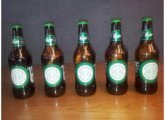
| What is the fastest way to cool a beer? | During the hot months of summer, people turn to a variety of methods to keep cool. While air conditioning and going to the beach are the more common remedies, for some nothing beats a cold beer.
|
Often beer is sold refrigerated however sometimes this is not the case. The Instrument Choice Scientists will be investigating a range of methods to get that beer cold in the shortest possible time frame.
For this we recorded 5 different methods using 5 of SA’s finest Cooper’s Pale Ale Stubbies. The methods included:
• A refrigerator
• A freezer
• An esky filled with ice
• An esky filled with ice, 2 cups of salt and water to make a slurry
• An esky with dry ice, the bottle was wrapped in paper to prevent direct contact of the dry ice with the glass as a safety precaution
Super Thermocron Temperature loggers were installed in each of the stubbies and suspended so that their sensor was not in contact with the bottle and set to take a sample every second. The stubbies were left at room temperature for 15 minutes to stabilise before being placed in the relevant vessel for cooling. All stubbies were left for 30 minutes to obtain a number of results. 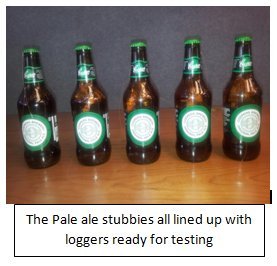
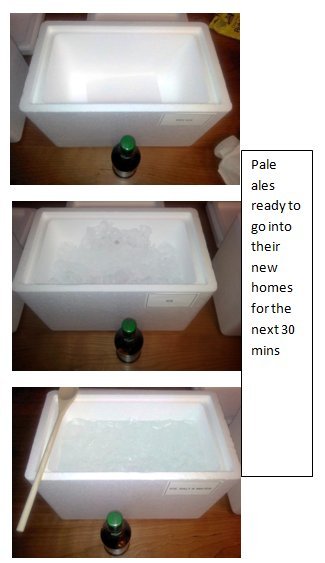
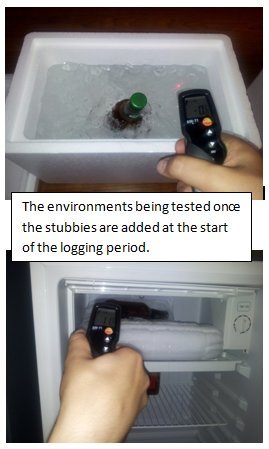
What were the results?
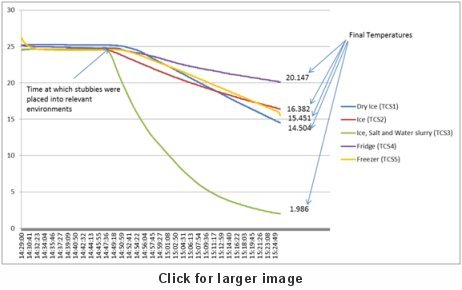
Somewhat surprisingly the fastest method turned out to be the ice, salt and water mix. We were under the impression that the dry ice would cool the beer at a faster rate however due to the small surface contact area it was almost as slow as the freezer despite its much lower temperature. The remainder were almost all on a level playing field, with the fridge being the slowest which was to be expected.
The reason the ice, water and salt mix cooled the beer in the quickest fashion is due to the fact the salt reduces the ice's melting point, allowing it to absorb more heat. The main disadvantage is that your ice will melt in a much shorter time frame. So, if you want to get a beer cooled quickly add some salt and water to your esky and you will have a nice cold beer in under 30 minutes. If you are looking to store your beer for a long period either an esky with ice or a fridge are still the most effective methods.
What experiment would you like us to do next? |
|
|






